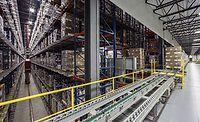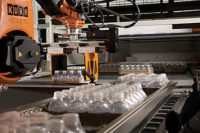Better Warehouse Inventory Management
By Molly V. Strzelecki
Storage systems provide solutions for handling a proliferation of SKUs
Companies in the beverage
industry are consolidating left and right. Big players are gobbling up
smaller ones, incorporating new brands into a growing cache of products.
Smaller players who remain independent continue to pump out new items for
consumers in an attempt to keep up with larger competitors. All of this has
resulted in an influx of products hitting the beverage aisles.
But before these products even hit the store shelves,
the increase in SKUs has made storage systems more important to beverage
producers and distributors than ever before. Most experts estimate that
those beverage companies that have consolidated have gone from SKUs in the
low hundreds to approaching the 600 to 700 SKU mark in their warehouses.
“The beverage business in whole — from
soft drinks to the beer and liquor and wine market — is changing
drastically, and they’re doing so in order to survive, especially the
individual owners of distributors,” says John Chauncey, director of
Boston Rack Inc., North Easton, Mass. “They’ve now got these
additional SKUs, which means they’ve got to find better ways to store
them, and they’ve also got to find a better way to keep track of the
inventory they have.”
But it’s not just the big players who are
rethinking how they store their products. While smaller players may not be
handling 600 SKUs, they are still handling more products than ever, and
efficient and well-managed storage systems are key to their success as
well.
“Consolidation in the industry is forcing a
paradigm shift in distribution from small operations with a relatively few
number of routes to massive operations with hundreds of routes,” says
Stephen E. Hoffman, technology specialist, software engineering for Grand
Rapids, Mich.-based Dematic Corp. “It is becoming increasingly
difficult to run an operation with pallets of floor-stacked products,
shoe-string warehouse management software and paper pick lists. To that
end, more and more storage racks are being introduced to the warehouse.
Warehouse management software is becoming more and more
prevalent.”
Hoffman, as well as others in the storage systems
industry, points out that technology such as voice-picking and automated
storage retrieval systems (AS/RS) are the touchstones for helping
production centers and warehouse distributors better manage the continuing
growth of SKUs.
New storage scene
An increase in SKUs can mean more business for
beverage companies, but it can also mean more errors.
“Some companies have grown 50 to 75 percent in
their SKUs in the last year, and that can hurt picking rates,”
explains Jeff Stingle, vice president of Vertique, Arden, N.C. “It
makes it more difficult and increases errors, and therefore starts to push
the need even more for automation in the case picking end of the
business.”
Stingle adds that the automation systems lend
themselves to helping reduce errors. Different systems have different
capabilities, but whether they are fully automated voice-picking systems
with robotics or just have the simplest automation for building pallets,
they all aid in counting, managing and picking accurately in the warehouse.
The number of SKUs being stored may be expanding, but
that doesn’t mean that all facilities are. Increasing product numbers
in non-increasing square-footage means that warehouse managers have to get
a little creative in their construction. Many storage system providers have
introduced high-density storage systems to combat the lack of floor space.
“To create more space within the warehouse,
we’ve done more high-density storage, such as the dual-wide drive in
system,” explains Doug Hayden, vice president of beverage sales for
South Bend, Ind.-based Twinlode. “Companies can put their core brands
and reserve storage in, taking that product three- and four-high, whereas
traditionally they’ve just been two-high pallets stacked on the
floor. It doubles the capacity in the same cube.”
Using space better, Hayden notes, frees up more floor
area, and gives companies better case flow to the pick area.
York, Pa.-based Westfalia Technologies Inc. also has
come up with an innovative concept to handle storage. Instead of a forklift
truck running in the aisle storing pallets on the right and left, a crane
picks up pallets and stores them in a rack system. With a dedicated crane
per aisle, the complete operation is in a safe and locked environment,
while also reducing the amount of stretchwrapping needed to keep the
product on the pallet.
“With these fully automated systems, including a
long conveyor line to queue the pallets up to store automatically in the
warehouse, it’s a smooth transaction, and eliminates a lot of
damages, and dramatically reduces the packaging material and
shrinkwrapping,” says Juergen Conrad, director of sales for
Westfalia.
Environmental effects
While advances in storage systems are helping beverage
producers and distributors better handle their rapidly multiplying SKUs,
some outside factors are influencing how these systems fit in the overall
picture.
“Environmental factors have impacted
dramatically,” Conrad says. “It is one of the most important
factors, and these systems, particularly our system, can be built for
smaller footprints. We can go multiple deep with the technology of having
two cranes in the aisle. The whole construction of our system can be in a
small, condensed and efficient warehouse.” Conrad also notes that
Westfalia’s high-density AS/RS allows less dirt in warehouses by
eliminating fleets of forklift trucks that track in dirt through rubber
tires, gas engines and other components.
Besides impacting the environment, manufacturers and
distributors also are taking into account other rising factors that impact
how they do business.
“The way products go to market [is a factor], as
labor continues to go up, insurance continues to go up and maintaining your
employees has gone up,” Vertique’s Stingle points out.
“Because of the cost of fuel, anything you can do to deliver better
and be more efficient on the road is going to impact across the bottom
line.”
“Steel prices are always a concern,”
Hayden notes. “They’ve been rising for the past few years.
However, we have not seen that diminish or cut back on sales. If anything,
it’s something that our clients are having to plan for and deal with
the increase in steel cost and availability of steel, because there is
still a need for them to add pallet racking or add storage methods to
accommodate the trends that are happening.”
Storing for the future
For those providing storage solutions, continued
consolidation in the industry means that while business will continue to
increase steadily, it is imperative that innovation and new technologies
increase as well. Voice-picking and continued solutions for high-density
storage are leading the charge.
“If the model is correct, you’re going to
see an increase in SKUs from the larger beverage companies so that
they’re better able to present more options to their customers at the
storefront,” Hayden says. “The trend seems to be at some point
perhaps automating the pick areas, which we’ve certainly seen on the
production side, with very cutting-edge technology.”
Efficiency is one buzzword for the future of storage
systems, as the proliferation of SKUs grows and managing them gets
trickier. Conrad notes that technology in Europe is starting to show itself
here in the United States.
“I see the same kind of efficiency and
productivity from companies [in the United States] because in our world
today everything has to be delivered the next day,” Conrad says.
“What you purchase today by a mouse click, you want to see in the
store the next day.” He adds that warehouse management software is
also a key factor in the efficiency game.
“You can’t handle the amount of products
and pallets without having a completely organized and automated
warehouse,” he says.
Software that interfaces with any host system, can
completely organize the warehouse and, in Westfalia’s case, control
the cranes doing the picking, is essential for a good storage system.
As beverage companies big and small continue to
increase their SKUs, new technology and innovations in storage systems
aren’t just good inventory management practices, they’re
essential for running a smooth operation.




